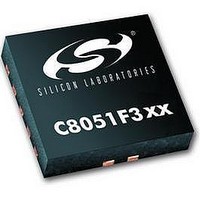C8051F302 Silicon Laboratories Inc, C8051F302 Datasheet - Page 133

C8051F302
Manufacturer Part Number
C8051F302
Description
IC 8051 MCU 8K FLASH 11MLP
Manufacturer
Silicon Laboratories Inc
Series
C8051F30xr
Specifications of C8051F302
Core Processor
8051
Core Size
8-Bit
Speed
25MHz
Connectivity
SMBus (2-Wire/I²C), UART/USART
Peripherals
POR, PWM, Temp Sensor, WDT
Number Of I /o
8
Program Memory Size
8KB (8K x 8)
Program Memory Type
FLASH
Ram Size
256 x 8
Voltage - Supply (vcc/vdd)
2.7 V ~ 3.6 V
Data Converters
A/D 8x8b
Oscillator Type
External
Operating Temperature
-40°C ~ 85°C
Package / Case
11-VQFN
Data Bus Width
8 bit
Data Ram Size
256 B
Interface Type
I2C, SMBus, UART
Maximum Clock Frequency
25 MHz
Number Of Programmable I/os
8
Number Of Timers
16 bit
Operating Supply Voltage
2.7 V to 3.6 V
Maximum Operating Temperature
+ 85 C
Mounting Style
SMD/SMT
Minimum Operating Temperature
- 40 C
On-chip Adc
8 bit
Lead Free Status / RoHS Status
Contains lead / RoHS non-compliant
Eeprom Size
-
Lead Free Status / Rohs Status
No
Available stocks
Company
Part Number
Manufacturer
Quantity
Price
Company:
Part Number:
C8051F302-GMR
Manufacturer:
SiliconL
Quantity:
3 000
Company:
Part Number:
C8051F302-GMR
Manufacturer:
SILICON
Quantity:
5 000
Part Number:
C8051F302-GMR
Manufacturer:
SILICONLABS/èٹ¯ç§‘
Quantity:
20 000
15.
Each MCU includes 3 counter/timers: two are 16-bit counter/timers compatible with those found in the standard
8051, and one is a 16-bit auto-reload timer for use with the ADC, SMBus, or for general purpose use. These timers
can be used to measure time intervals, count external events and generate periodic interrupt requests. Timer 0 and
Timer 1 are nearly identical and have four primary modes of operation. Timer 2 offers 16-bit and split 8-bit timer
functionality with auto-reload.
Timers 0 and 1 may be clocked by one of five sources, determined by the Timer Mode Select bits (T1M-T0M) and
the Clock Scale bits (SCA1-SCA0). The Clock Scale bits define a pre-scaled clock from which Timer 0 and/or
Timer 1 may be clocked (See Figure 15.6 for pre-scaled clock selection).
Timer 0/1 may then be configured to use this pre-scaled clock signal or the system clock. Timer 2 may be clocked by
the system clock, the system clock divided by 12, or the external oscillator clock source divided by 8.
Timer 0 and Timer 1 may also be operated as counters. When functioning as a counter, a counter/timer register is
incremented on each high-to-low transition at the selected input pin. Events with a frequency of up to one-fourth the
system clock's frequency can be counted. The input signal need not be periodic, but it should be held at a given level
for at least two full system clock cycles to ensure the level is properly sampled.
15.1. Timer 0 and Timer 1
Each timer is implemented as 16-bit register accessed as two separate bytes: a low byte (TL0 or TL1) and a high byte
(TH0 or TH1). The Counter/Timer Control register (TCON) is used to enable Timer 0 and Timer 1 as well as indicate
their status. Timer 0 interrupts can be enabled by setting the ET0 bit in the IE regitser
Register Descriptions” on page
tion
T0M0 in the Counter/Timer Mode register (TMOD). Each timer can be configured independently. Each operating
mode is described below.
15.1.1. Mode 0: 13-bit Counter/Timer
Timer 0 and Timer 1 operate as 13-bit counter/timers in Mode 0. The following describes the configuration and oper-
ation of Timer 0. However, both timers operate identically, and Timer 1 is configured in the same manner as
described for Timer 0.
The TH0 register holds the eight MSBs of the 13-bit counter/timer. TL0 holds the five LSBs in bit positions TL0.4-
TL0.0. The three upper bits of TL0 (TL0.7-TL0.5) are indeterminate and should be masked out or ignored when read-
ing. As the 13-bit timer register increments and overflows from 0x1FFF (all ones) to 0x0000, the timer overflow flag
TF0 (TCON.5) is set and an interrupt will occur if Timer 0 interrupts are enabled.
The C/T0 bit (TMOD.2) selects the counter/timer's clock source. When C/T0 is set to logic 1, high-to-low transitions
at the selected Timer 0 input pin (T0) increment the timer register (Refer to
Decoder” on page 96
defined by the T0M bit (CKCON.3). When T0M is set, Timer 0 is clocked by the system clock. When T0M is
cleared, Timer 0 is clocked by the source selected by the Clock Scale bits in CKCON (see Figure 15.6).
Timer 0 and Timer 1 Modes:
Two 8-bit counter/timers (Timer 0 only)
8-bit counter/timer with auto-reload
8.3.5). Both counter/timers operate in one of four primary modes selected by setting the Mode Select bits T1M1-
TIMERS
13-bit counter/timer
16-bit counter/timer
for information on selecting and configuring external I/O pins). Clearing C/T selects the clock
70); Timer 1 interrupts can be enabled by setting the ET1 bit in the IE register
Timer 2 Modes:
Two 8-bit timers with auto-reload
16-bit timer with auto-reload
Rev. 2.3
C8051F300/1/2/3/4/5
Section “12.1. Priority Crossbar
(Section “8.3.5. Interrupt
(Sec-
133











